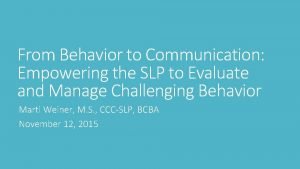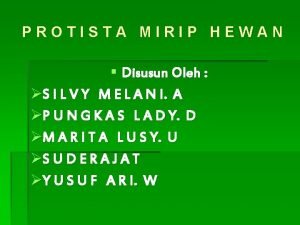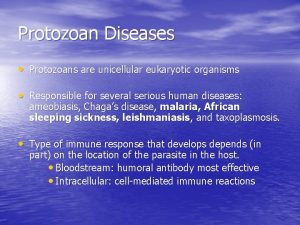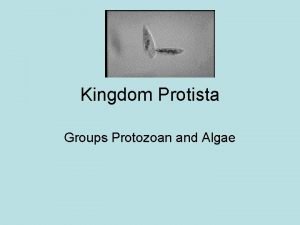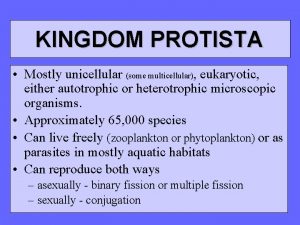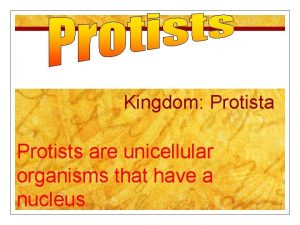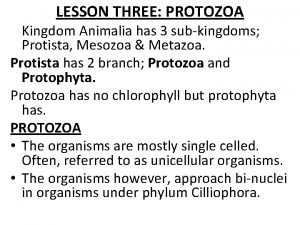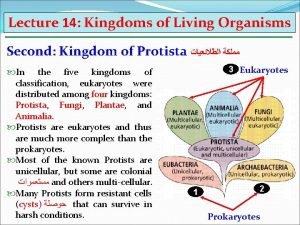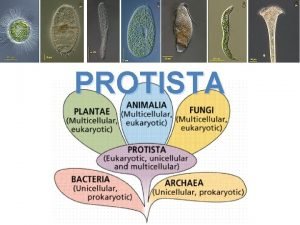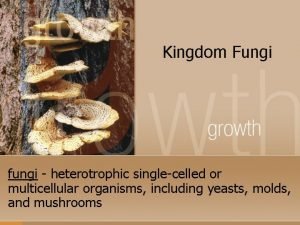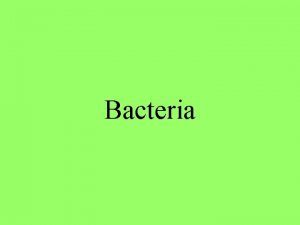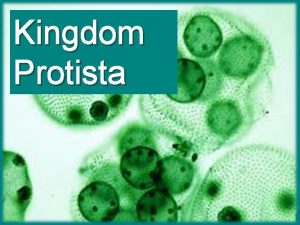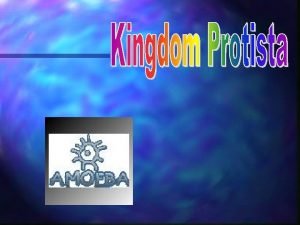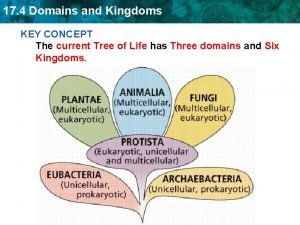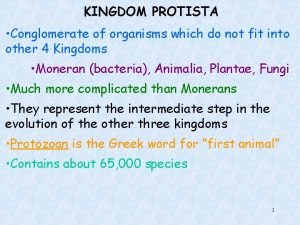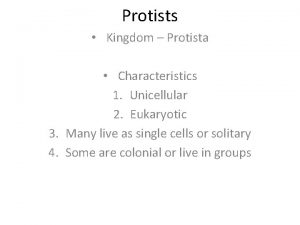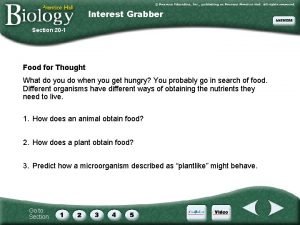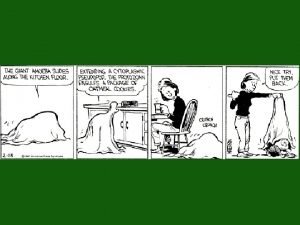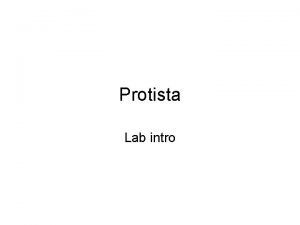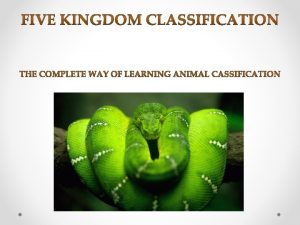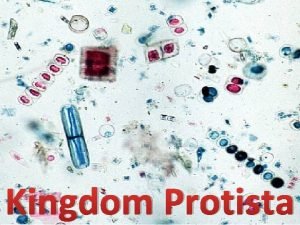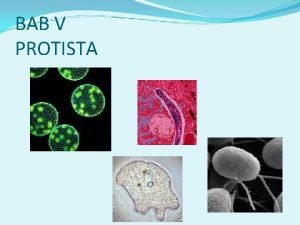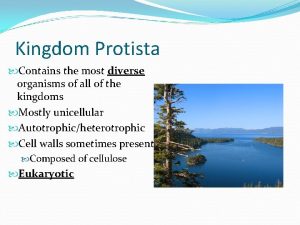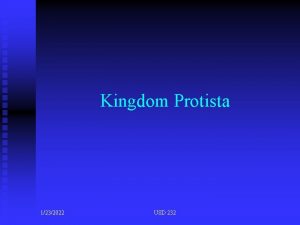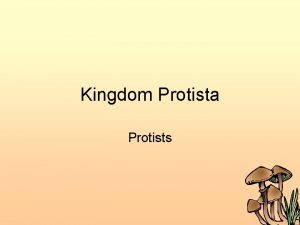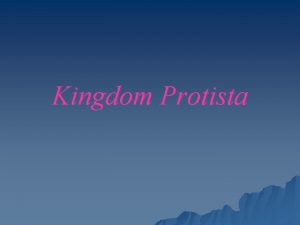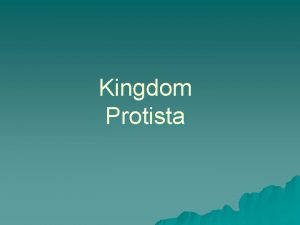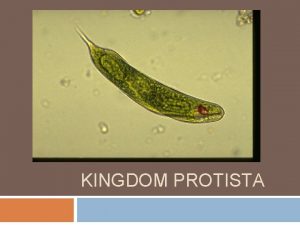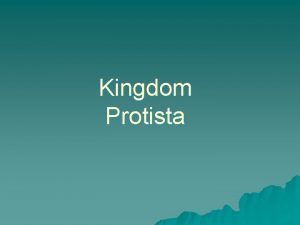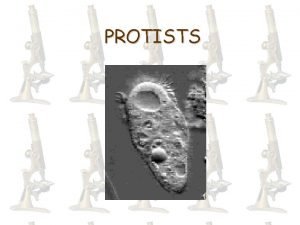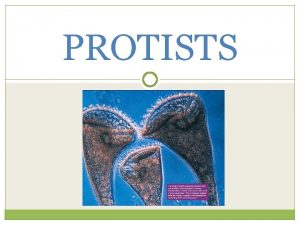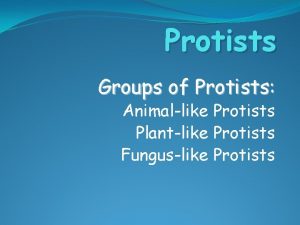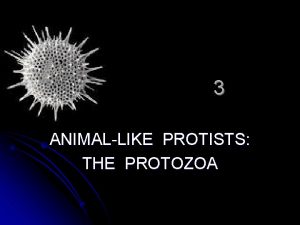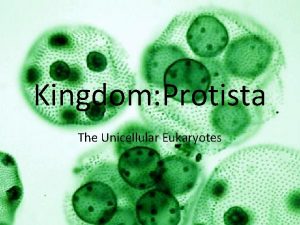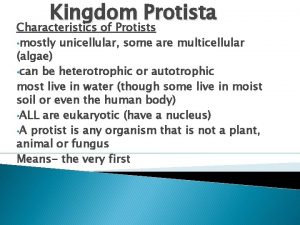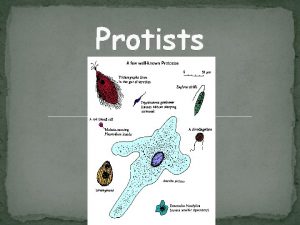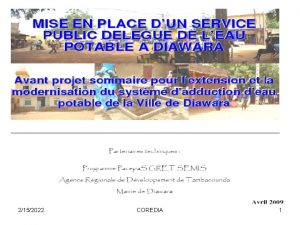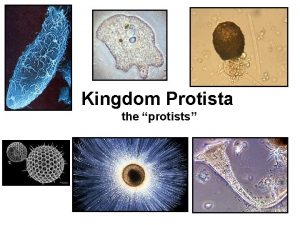Kingdom Protista 2152022 USD 232 Protozoa unicellular protists


































- Slides: 34

Kingdom Protista 2/15/2022 USD 232

Protozoa (unicellular protists) Phylum Sarcodina n Phylum Ciliophora n Phylum Zoomastigina n Phylum Sporoza n 2/15/2022 USD 232

Algae and Fungus Phylum Chlorophyta n Phylum Phaeophyta n Phylum Rhodophyta n Phylum Dinoflagellata n Phylum Chrysophyta n Phylum Euglenophyta n 2/15/2022 USD 232

Protozoa General Characteristics Single celled n They can move n Most are heterotrophic (free living, some are parasitic) n Found everywhere there is water n Are the first link in aquatic food chains (zooplankton) n 2/15/2022 USD 232

Protozoa General Characteristics (cont. ) Some have eyespots for detecting chemicals and light n Probably evolved from prokaryotic cells 3. 5 to 5 billion years ago through endosymbiosis n 2/15/2022 USD 232

Protozoa Reproduction Multiple fission-more than one are produced from a binary split n Conjugation-sexual n Binary fission-asexual n 2/15/2022 USD 232

Phylum Sarcodina Movement-Cytoplasmic streaming using amoeboid movement Structures-Contractile vacuole, pseudopodia 2/15/2022 USD 232

Sarcodina Characteristics Environmental role-Some have shells called “Tests, ” which are made of calcium carbonate. This chalky compound colors the Cliffs of Dover in England produced the stones that built the pyramids. n Entamoeba histolytica causes amebic dysentery. Lives in contaminated food/water. Explosive diarrhea and vomiting. n 2/15/2022 USD 232

Phylum Ciliophora Movement-Cilia Structures-Pellicle, oral groove, mouth pore, gullet, anal pore, macrocnucleus, micronucleus Reproduction-Use conjugation 2/15/2022 USD 232

Phylum Zoomastigina Movement-One or more flagella n Diseases u Trypanosoma-live in insects, cause African Sleeping sickness (Tsetse) u Leishmania donovani-caused by sandflies, a disease of the blood that causes lesions and sores, can be fatal n 2/15/2022

Zoomastigina Characteristics n Diseases u Trypanosoma-live in insects, cause African Sleeping sickness (Tsetse) u Leishmania donovani-caused by sandflies, a disease of the blood that causes lesions and sores, can be fatal u Giardia lamblia-Carried by animals (beaver’s) causes explosive diarrhea and abdominal cramping 2/15/2022

Phylum Sporozoa n Movementadults carried by blood stream, usually parasitic 2/15/2022

Sporozoa Characteristics Diseases u Toxoplasmosis-Protozoan lives in birds, rodents, and cats. Is not harmful to adults but can be dangerous to developing fetus. u Plasmodium-Carried by anopheles mosquito. Causes Malaria-victims die from anemia, kidney failure, or brain damage; has killed more people than any other Genus, 2. 7 million die annually. n Summary of life cycle 2/15/2022 n

Algae and Fungus Cereval Characteristics Like Protists. Most unicellular, some multicellular. n Range from microscopic to the huge n Photosynthetic-contains chloroplasts n No roots, stems, leaves n Form Gametangia from gametes n Contain pyrenoids that synthesize starch n Body called a thallus n 2/15/2022

Algae and Fungus Cereval Characteristics (cont. ) n There are four types of Algae: u Unicellular-photoplankton (photosynthetis single celled organism that makes up the foundation of the food chain. u Colonial-volvox: group of cells acting as one u Filamentous-spirogyra: made of cellular sections u Multicellular-Ulva (see lettuce) 2/15/2022

Algae and Fungus Reproduction Algae reproduce sexually and asexually n Must be familiar with the following key vocabulary Meiosis Mitosis Zoospore Zygote Gamete Haploid Diploid Gametophyte Sporophyte Oogonium Antheridium n 2/15/2022

Oedogonium (sexual) 2/15/2022

Oedogonium Reproduction 2/15/2022

Chlamydomas (sexual and asexual) 2/15/2022

Chlamydomas Reproduction 2/15/2022

Ulva (Alternation of generations) 2/15/2022

Spirogyra (conjugation) 2/15/2022

Phylum Chlorophyta (green algae) Colonial/multicellular n Most aquatic n Form symbiotic partnership with bacteria/fungus called lechen n Bottom of food chain n 2/15/2022

Phylum Phaeophyta (brown algae) Seaweed and kelp n Cool oceans n Large and multicellular n 2/15/2022

Phylum Rhodophyta (red algae) Fresh/salt water n Deep water algae n Used to make carageenan which cosmetics, gelatin, cheese, agar n 2/15/2022

Phylum Bacillariophyta Fresh/salt water n Major component of phytoplankton which is the bottom of marine food chain. n Used to make toothpaste, detergents, paint remover, fertilizer, insulators n 2/15/2022

Phylum Dinoflagellata Most are photosynthetic and unicellular n Produce Bioluminescence n Cause red tide n 2/15/2022

Phylum Chrysophyta (golden algae) Have cysts that can remain frozen n Important in the production of petroleum deposit n Two flagella n 2/15/2022

Phylum Euglenophyta Photosynthetic but can be heterotrophic if necessary n Lives in the guts of many animals (symbiosis) n General Anatomy n 2/15/2022

Fungus-like Protists Eat like amoebas but reproduce like fungi n Structure resembles protists n Two major phyta acrasiomyta and myxomycota n Two major phyla of water molds are oomycote and chytrimycote n 2/15/2022

Acrasiomyta They can swim or move by amoebic movement n If food is scarce they will combine with other single celled members and work as a team (pseudoplasmodium) n 2/15/2022

Myxomycota Eats detritis (dead leaves and organic material) n Produces multicolored visible reproductive structures n 2/15/2022

Oomycota Eats dead fish in aquarium n Caused potato blight in Ireland is a pathogen for many plants n 2/15/2022

Chytridiomycota n Protist that is heterotrophic on other protists 2/15/2022
 Usd 232
Usd 232 Phyrophyta
Phyrophyta Protista is unicellular or multicellular
Protista is unicellular or multicellular Protozoans are unicellular
Protozoans are unicellular Roman empire
Roman empire Mentohotep
Mentohotep Old kingdom middle kingdom new kingdom
Old kingdom middle kingdom new kingdom Nnn ruled
Nnn ruled Mastigophora examples
Mastigophora examples Protists unicellular or multicellular
Protists unicellular or multicellular Are protists unicellular or multicellular
Are protists unicellular or multicellular Are protists unicellular
Are protists unicellular Subkingdoms of animalia
Subkingdoms of animalia Macronucleus
Macronucleus What kingdom is photosynthetic aquatic and unicellular
What kingdom is photosynthetic aquatic and unicellular Are fungi single or multicellular
Are fungi single or multicellular Unicellular prokaryotes kingdom
Unicellular prokaryotes kingdom Kingdom fungi unicellular or multicellular
Kingdom fungi unicellular or multicellular Distinguishing features of kingdom protista
Distinguishing features of kingdom protista Kingdom protista introduction
Kingdom protista introduction How do all members of the phylum ciliophora move
How do all members of the phylum ciliophora move Domains and kingdoms
Domains and kingdoms Animal like protists definition
Animal like protists definition Eukarya plantae
Eukarya plantae 2 characteristics of protista
2 characteristics of protista Section 20-1 the kingdom protista
Section 20-1 the kingdom protista Importance of kingdom protista
Importance of kingdom protista Sarcodina habitat
Sarcodina habitat Kingdom protista classification chart
Kingdom protista classification chart Protista, fungi, plantae, animalia *
Protista, fungi, plantae, animalia * General characteristics of protista
General characteristics of protista Protist is
Protist is Ciri umum protozoa
Ciri umum protozoa Sexual reproduction
Sexual reproduction Monera protista fungi plantae animalia
Monera protista fungi plantae animalia
